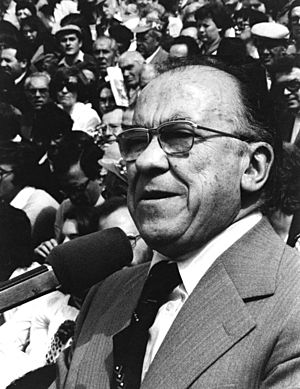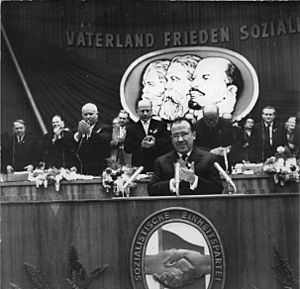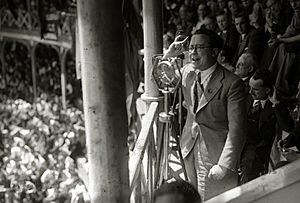Santiago Carrillo facts for kids
Quick facts for kids
Santiago Carrillo
|
|
|---|---|
 |
|
| Secretary-General of the Communist Party of Spain |
|
| In office 3 July 1960 – 10 December 1982 |
|
| Preceded by | Dolores Ibárruri |
| Succeeded by | Gerardo Iglesias |
| Councillor of Public Order of the Madrid Defense Council |
|
| In office 6 November 1936 – 27 December 1936 |
|
| President | José Miaja |
| Preceded by | Position established |
| Succeeded by | José Cazorla |
| Secretary-General of the Unified Socialist Youth |
|
| In office 15 June 1936 – 20 June 1947 |
|
| Secretary-General of the Socialist Youth of Spain |
|
| In office 10 May 1934 – 15 June 1936 |
|
| Member of the Congress of Deputies | |
| In office 13 July 1977 – 23 April 1986 |
|
| Constituency | Madrid |
| Personal details | |
| Born |
Santiago José Carrillo Solares
18 January 1915 Gijón, Asturias, Spain |
| Died | 18 September 2012 (aged 97) Madrid, Spain |
| Political party | PCE (1936–1985) PTE–UC (1985–1991) |
| Spouses | Asunción Sánchez de Tudela (1936) Carmen Menéndez Menéndez (1949) |
| Children | Aurora, Santiago, José, Jorge |
| Signature |  |
Santiago José Carrillo Solares (born January 18, 1915 – died September 18, 2012) was an important Spanish politician. He was the leader of the Communist Party of Spain (PCE) from 1960 to 1982.
During the Spanish Civil War, he was in charge of keeping public order in Madrid. After the war, he lived in exile during the time Francisco Franco ruled Spain. He became a key leader of the groups that opposed Franco's government.
Later, he played a very important role in helping Spain become a democracy again. He believed in a type of communism called Eurocommunism, which was more democratic. He was also a member of the Spanish Parliament, called the Congress of Deputies, from 1977 to 1986.
Contents
Early Life and Youth
Santiago Carrillo was born in Gijón, a city in the Asturias region of Spain. His father, Wenceslao Carrillo, was a well-known Socialist leader. When Santiago was six years old, his family moved to Madrid.
He started working at the age of 13 for El Socialista, which was the newspaper of the Spanish Socialist Workers' Party (PSOE). At the same time, he joined the Socialist Youth group and a workers' union.
Second Republic and Civil War
In 1932, Santiago Carrillo became part of the Socialist Youth's main committee. He also became the editor of their newspaper, Renovación. He was part of the more radical side of the group. In 1933, he was chosen as the General Secretary of the Socialist Youth.
From October 1934 to February 1936, he was put in jail. This was because he took part in a failed uprising in 1934.
After he was released from prison in March 1936, Carrillo and other Socialist Youth leaders traveled to Moscow. There, they met with leaders of the Young Communist International. Their goal was to combine the Socialist and Communist youth groups. This led to the creation of the Unified Socialist Youth (Juventudes Socialistas Unificadas).
When the Spanish Civil War began, Carrillo joined the Communist Party. This happened in November, the same day the government left Madrid. During the war, he strongly supported the Soviet Union. On November 7, 1936, Carrillo was chosen as the Councillor for Public Order in the Defence Council of Madrid. This council had special powers in Madrid while the city was under attack.
During his time in this role, many prisoners were killed by Republican groups in what became known as the Paracuellos massacres. These events happened in Paracuellos de Jarama and Torrejón de Ardoz. Carrillo said in his memoirs that he did not know about these killings. However, some historians believe he was involved.
In March 1939, Madrid surrendered after a military action led by Colonel Casado. This action was against the government of Juan Negrín and its ally, the Communist Party. Carrillo's father, Wenceslao, was part of Casado's group. Santiago Carrillo wrote a strong letter to his father, calling his actions a betrayal. He said he would no longer communicate with him.
After the Republican government lost the war, Carrillo went to Paris. He spent 38 years living outside of Spain, mostly in France, but also in the USSR and other countries.
Life in Exile

In 1960, Carrillo became the General Secretary of the PCE. He took over from Dolores Ibárruri, who was given an honorary role. Carrillo worked to make the party stronger among workers and thinkers.
In 1968, when the Soviet Union and its allies invaded Czechoslovakia, Carrillo showed that his party was independent from Moscow. He wanted the Spanish Communist Party to be completely separate from the Soviet Union. He also worked for Spain to return to democracy peacefully.
Spain's Transition to Democracy
Carrillo secretly came back to Spain in 1976 after the death of Francisco Franco. He wore a wig to hide his bald head. He was arrested by the police but was released a few days later.
Together with other communist leaders from France and Italy, he started the Eurocommunist movement. This movement aimed for a more democratic form of communism. They held a meeting in Madrid on March 2, 1977.
In 1977, the PCE became legal in Spain. Soon after, in the first democratic elections, Carrillo was elected to the Spanish Congress of Deputies. He represented the Madrid district.
During Spain's move to democracy, Carrillo's leadership was very important. He helped ensure a peaceful change to a democratic system. He encouraged talking with opponents and healing the divisions from the Civil War. Many people agree that his approach was key to Spain's peaceful transition.
Carrillo was re-elected in 1979. However, a failed coup attempt by right-wing groups on February 23, 1981, reduced support for the PCE. This was because Spanish society was still recovering from the Civil War. Despite this, Carrillo famously stood up to the coup plotters in parliament. He was one of the few who refused to obey them and did not duck when they shot into the air.
Fear of another military uprising led to more support for moderate left-wing parties in the 1982 elections. Carrillo kept his seat in parliament. However, he had to step down as party leader on November 6, 1982. This was because the party did not do well in the elections.
Leaving the Communist Party
On April 15, 1985, Carrillo and his supporters were removed from the PCE. In 1986, they formed their own political group, the Workers Party of Spain-Communist Unity (PTE-UC). This new party did not get enough votes. So, on October 27, 1991, Carrillo announced that it would be closed down.
The PTE-UC later joined the ruling PSOE party. However, Carrillo chose not to become a member of the PSOE, given his many years as a communist.
Retirement and Death
On October 20, 2005, Carrillo received an honorary doctorate degree from the Autonomous University of Madrid. He had retired from public life when he passed away at his home in Madrid. He was 97 years old. He was cremated in Madrid on September 20, 2012.
Images for kids
See also
 In Spanish: Santiago Carrillo para niños
In Spanish: Santiago Carrillo para niños
- Jorge Semprún
- Eurocommunism
- History of Spain
- Politics of Spain



